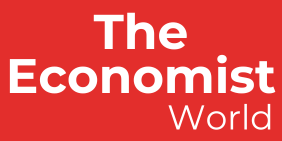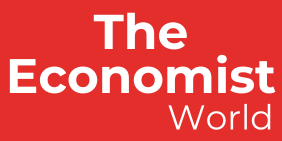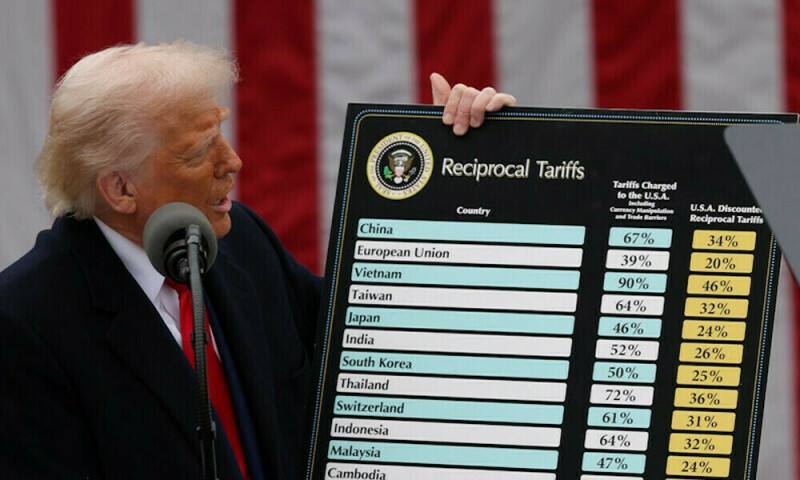Trump’s tariff hike sent shockwaves through global trade on Thursday, raising concerns among industries worldwide. However, for Pakistan’s textile sector, this move presents a challenge with a unique opportunity to pivot.
US President Donald Trump ignited a potentially ruinous trade war as he announced new tariffs on imports from around the world and harsh additional levies on key trading partners including Pakistan.
Pakistan stands poised to expand its footprint in the American market, potentially boosting exports and strengthening its position in the global textile industry, as the country still holds a cost advantage over key competitors like China, Vietnam, and Bangladesh, according to analysts and industry experts.
“The greater chances are that Pakistan’s textile exports will increase to its single largest destination of the US in the wake of Trump’s imposition of reciprocal tariff on imports from majority economies across the world including Pakistan,” Muhammad Zubair Motiwala, a textile manufacturer and former chief executive at the Trade Development Authority of Pakistan (TDAP), told Business Recorder.
What’s in Trump’s sweeping new reciprocal tariff regime
The US imposed significantly higher reciprocal tariff on import from many competitor countries compared to Pakistan: 34% on China, 37% on Bangladesh, 46% on Vietnam, and 49% on Cambodia. On the other hand, Trump imposed comparatively a lower tariff of 29% on Pakistan products.
“Accordingly, the impact of the new tariffs on across the world should be positive on Pakistani exports, particularly at its textile exports to the US, as the tariff remains low on Pakistan compared to its competitor countries,” Motiwala said.
“The chances are that Pakistan will receive new textile export orders, as US buyers will cut their imports from those counties that received higher Trump tariffs, and divert their import orders to cheaper counties like Pakistan.”
Former TDAP official further said India was the only one country that received comparatively lower reciprocal tariff of 26% compared to 29% on Pakistani products.
“Pakistan may indulge into stiff competition with the regional country.”
US imported goods worth $3.36 trillion in 2024, up 6% year-on-year (YoY), as per data reported by Trade map. Country wise, Mexico’s share was highest in total imports of US at 15%, followed by China, Canada, Germany and Japan in range of 5-14%.
Pakistan share was only 0.16% in 2024 while countries like Vietnam, Bangladesh, Sri Lanka and India had share of 4.2%, 0.26%, 0.09% and 2.7%, respectively, brokerage house Topline Securities cited in a report.
“Although imports from Pakistan in US makes only 0.16% of total US imports, however, the number is quite significant from Pakistan’s perspective. Pakistan exports to US are $6bn annually, 18% of total exports of the country.
“Textile is the largest category (75-80%) in total exports to USA. While other exported products/commodities are leather, surgical goods, rice, cement, steel products, salt, etc among others,” it said.
Meanwhile, Karachi Chamber of Commerce and Industry (KCCI) former president and a textile exporter Javed Bilwani said the new tariff would come into effect from April 9, 2025. However, he added, the US traders demanded local exporters to bear 50% of the new additional cost on their imports that are en route from Pakistan.
US tariffs will hurt Pakistani products’ competitiveness, experts warn
A report from brokerage house Arif Habib Limited (AHL) stated that Pakistan industries like textiles, food, cement and others were expected to feel the pressure after Trump’s tariff hike.
“But amid this tariff storm, Pakistan has a unique chance to pivot, we believe, i.e. turning challenge into opportunity.
“While these tariffs may reduce export competitiveness and strain foreign exchange earnings, Pakistan still holds a cost advantage over key competitors like China, Vietnam, and Bangladesh,” it added.
According to the report, Pakistan must adopt a reciprocal and strategic approach, including reducing energy costs, negotiating tariff relief, and diversifying trade markets to mitigate the impact.
“If executed well, this challenge could be turned into an opportunity, helping Pakistan secure new investments, expand trade routes, and reposition itself in the evolving global supply chain,” it said.


